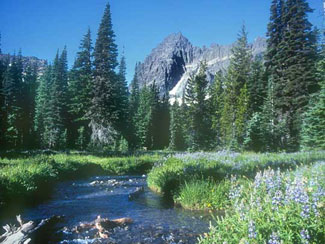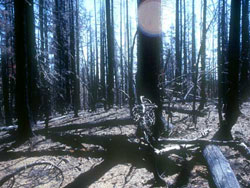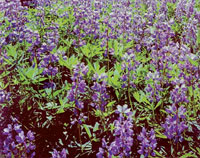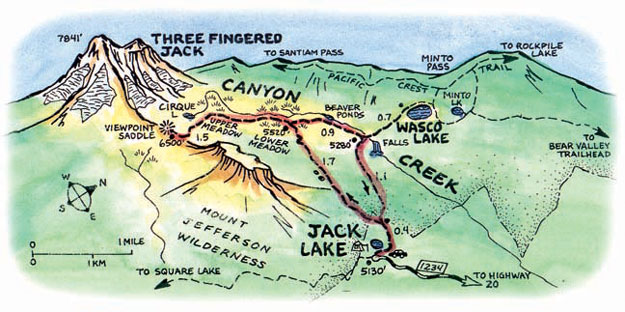
Try one of the easiest routes to the High Cascades' wildflower meadows, a loop leading to the craggy east face of Three Fingered Jack..
About the Hike: An easy loop visits Canyon Creek's lower meadow, full of wildflowers. For even better views, energetic hikers can continue to an upper meadow and a viewpoint beneath Three Fingered Jack's summit pinnacles.
Difficulty: A moderate 4.5-mile loop with 400 feet of elevation gain to the lower meadow, or a difficult 7.5-mile loop with 1400 feet of elevation gain to the upper meadow's viewpoint.
Season: mid-July through October.
Getting There: Drive Highway 20 east of Santiam Pass 8 miles. At a "Wilderness Trailheads" sign near milepost 88 (1 mile east of Suttle Lake or 12 miles west of Sisters), turn north on paved Jack Lake Road 12 for 4.4 miles. Then turn left on one-lane Road 1230 for 1.6 miles to the end of pavement, and finally turn left onto Road 1234, climbing 6 miles to the trailhead at the primitive Jack Lake campground.
Fees: A Recreation Fee Pass (Northwest Forest Pass) parking permit is required at the trailhead. It costs $5 per car per day or $30 per season.
Hiking Tips: The first mile of the hike traverses a stand of silver snags from a 2003 forest fire. From the Jack Lake campground parking area, start hiking on the trail to the right, skirting Jack Lake's shore. This path climbs 0.3 mile to a well-marked fork at the Wilderness boundary: the start of the loop.
To limit the number of people you meet, the Forest Service asks that you hike the loop clockwise. So bear left at this junction, climb gradually amid snags, pass two ponds atop a small ridge, and descend through unburnt woods to the lower meadow.
 Here the view of Three Fingered Jack's snow-clad crags emerges and the wildflower displays begin in earnest. Do not trample these delicate alpine gardens. Stay on the main trail and choose a picnic spot amid trees. Backpackers must camp at least 100 feet from trails or water.
Here the view of Three Fingered Jack's snow-clad crags emerges and the wildflower displays begin in earnest. Do not trample these delicate alpine gardens. Stay on the main trail and choose a picnic spot amid trees. Backpackers must camp at least 100 feet from trails or water.
If you still have plenty of energy, continue 0.7 mile up the trail to the rim of the rock-strewn upper meadow, a glacial outwash plain. From here the 0.8-mile route to the 6500-foot-elevation viewpoint becomes less distinct.
Climb south up a steep, rocky moraine to a notch overlooking a stunning, green cirque lake at the foot of Three Fingered Jack's glacier. Next the path follows the somewhat precarious crest of the moraine, scrambling steeply up to a windy saddle, where the view stretches from Mount Jefferson to the Three Sisters. Sharp eyes can often spot climbers on the spires of Three Fingered Jack.
 To return via the loop, hike back to the bottom of the lower meadow and turn left. This path follows Canyon Creek past a fascinating beaver workshop, where dozens of large pines have been ringed and felled. Rings six feet above the ground prove the beavers are active even when winter snowdrifts remain. At this point you'll reenter the zone of snags left by the 2003 wildfire.
To return via the loop, hike back to the bottom of the lower meadow and turn left. This path follows Canyon Creek past a fascinating beaver workshop, where dozens of large pines have been ringed and felled. Rings six feet above the ground prove the beavers are active even when winter snowdrifts remain. At this point you'll reenter the zone of snags left by the 2003 wildfire.
Half a mile beyond the beaver trees, join the trail from Wasco Lake. But before turning right to return to the car, follow the sound of falling water to a footbridge below the first of Canyon Creek Falls' two lovely, 12-foot cascades.
History: The B&B forest fire burned a third of the Mt. Jefferson Wilderness in 2003, but the cliffs surrounding Canyon Creek Meadows served as a natural fire break, leaving the valley as a "donut hole" of green in the midst of the burn. You'll hike past silver snags at the start and end of this hike, but even here you'll notice that millions of mountain hemlock seedlings have sprouted naturally after the fire. Beargrass, huckleberries, and many other plants that rely on fire are thriving as well.
Geology: Three Fingered Jack is the heavily eroded plug, or core, of an extinct 100,000-year-old volcano. The colorful stripes you see in the mountain's cliffs are a cross-section of the yellow ash flows, red cinders, and black lava that originally built up the peak. A tiny remnant of the once mighty glacier that carved Canyon Creek's valley remains at the foot of the mountain's east face.
By William Sullivan
